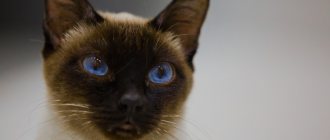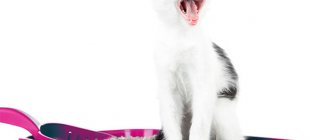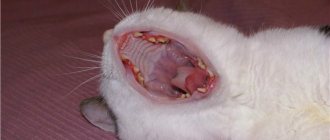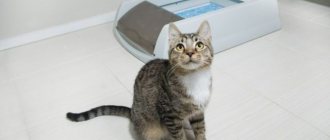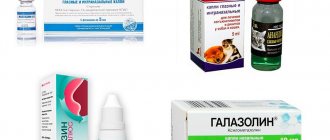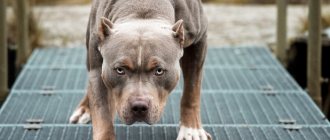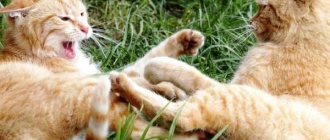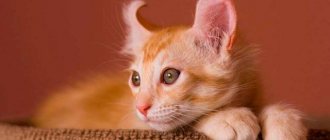How does hypersalivation manifest?
Normal salivation in cats is called salivation, and increased salivation is called hypersalivation. If there is a deviation from the norm, you need to pay attention to the accompanying symptoms.
Normal salivation
First of all, saliva is needed to moisten the food being absorbed. Severe drooling is observed in cats eating dry food. This is absolutely normal. Saliva moistens the dry granules, making them easier to swallow and pass through the esophagus. It also performs a protective function: it disinfects swallowed pieces of food, prevents damage to tooth enamel and oral mucosa.
Hypersalivation in a kitten occurs when baby teeth erupt. With the advent of a full combat set, it stops by itself.
With normal drooling in cats, the fur around the mouth becomes slightly wet. If saliva drips constantly, worsening the quality of the coat, and its volume gradually increases, consult a doctor. This situation requires mandatory diagnosis.
Abnormal salivation
In addition to the deterioration in the quality of fur on the face, neck and chest, the owner should be alert to other alarming symptoms:
- the formation of wet marks in the place where the pet sleeps;
- the tongue falling out of the mouth, which occurs due to its lethargy;
- increasing the number of daily washes;
- making frequent swallowing movements.
In the presence of pathology, hypersalivation is complemented by concomitant symptoms. The patient's appetite decreases, apathy or increased excitability appears. If the condition worsens, gastrointestinal disorders (vomiting, diarrhea), fever and cough may occur.
Signs
What is hypersalivation? This is the name for increased salivation in cats. This condition does not necessarily indicate that the pet is unhealthy. Most often, excessive salivation is caused by natural causes. However, you should take a closer look at the animal’s well-being so as not to miss signs of possible diseases.
Most often, hypersalivation is clearly visible. However, there are cases when drooling is not pronounced, and it can be determined by the following indirect signs:
- wet fur in the neck, chin and chest;
- frequent washing of the pet;
- hanging wet wool in the form of “icicles”;
- tongue sticking out;
- the appearance of moisture stains on the sleeping mat;
- frequent rubbing of the animal against various objects.
The secretion of the salivary glands may flow out of the mouth in droplets, like water, or be released in the form of foam. If hypersalivation is accompanied by changes in the cat's behavior, then it is possible that this is due to a disease.
Causes not related to illness
The causes of increased salivation in a cat are not related to breed. Hypersalivation occurs not only in purebred pets, but also in mixed breeds. In most cases, it is explained by physiology and does not require treatment.
Taking a bitter medicine or licking a chemical substance
When taking bitters orally, an unpleasant taste occurs in the mouth, accompanied by slight numbness. In an attempt to get rid of bitterness, the salivary glands begin to work in enhanced mode. The amount of fluid released and the duration of its flow are individual. On average, the process takes no more than 20 minutes. With long-term use of medications, hypersalivation occurs not only after swallowing the substance, but also shortly before.
It is better to avoid licking chemicals. In this case, excessive salivation is the most favorable outcome. Frequent contact with household chemicals or other hazardous substances can result in serious intoxication.
If your pet licks a package of toilet cleaner right in front of your eyes, then most likely nothing will happen to him. To be safe, watch him for a while and be sure to hide the chemical away from his eyes and agile paws.
Motion sickness while traveling
Animals, like people, are not immune to motion sickness in transport. In addition to increased salivation, nausea and vomiting may occur during the trip. All of the above symptoms disappear on their own at the end of the trip.
Anesthesia
The work of the salivary glands slows down during natural sleep and similar conditions caused artificially. Soon after waking up from anesthesia, the animal experiences increased production of saliva. After replenishing the required volume of fluid, the work of the glands returns to their usual rhythm.
Great hunger
If a cat drools regularly, then the reason for this phenomenon is quite simple. When feeding hourly, the animal's biological clock signals that food is about to be taken. The feeling of hunger intensifies, and a thin stream of saliva appears from the mouth.
Try to avoid taking too long breaks, as real hunger stimulates the production of gastric juice. Due to increased acidity, your pet may develop erosion or ulcers.
Excess of affection
Hypersalivation is typical for affectionate pets that “melt” under the owner’s stroking. When reaching maximum pleasure, they not only purr loudly, but also drool. Most often, this feature is found in sphinxes and orientals.
Foreign object in teeth
The cause of excessive salivation in a cat may be a foreign object stuck in the teeth. If your pet constantly licks itself, carefully examine its oral cavity. In the absence of an abscess and inflammation, a stuck bone, piece of food or other foreign object can be removed with ordinary tweezers.
If there is a decrease in appetite, frequent coughing or vomiting, it is better to consult a veterinarian. The appearance of blood, the main symptom of internal damage, is especially dangerous. Surgery may be required to save the cat.
Old age
With age, bones become more fragile. First of all, this affects the teeth. They wear out and fall out faster. Because of this, the gums are more vulnerable and are often affected by pathogens. To prevent the inflammatory process, the salivary glands begin to work in enhanced mode.
Cats over 12 years old often suffer from caries, gingivitis and periodontal disease. To maintain the health of their teeth, it is necessary to regularly maintain oral hygiene and undergo a preventive examination at the veterinary clinic at least 2 times a year.
Diagnostics
Hypersalivation can be a symptom of a variety of diseases. Only a specialist can determine the exact cause of excessive salivation. At the initial visit, the doctor conducts a thorough examination of the animal and prescribes the following examinations:
If you suspect inflammatory processes in the oral cavity, you may need to consult a veterinary dentist.
Pathological causes
It is worth thinking about pathology if hypersalivation occurs at different times of the day and lasts more than 2 hours with a stable increase in saliva volume. Based on the accompanying symptoms, you should try to make a preliminary diagnosis yourself, since one of the possible causes is fatal to humans.
Virus: rabies, calcivirosis, rhinotracheitis
Drooling in cats occurs when infected with viruses. Depending on the symptoms, the pet may be infected:
- Rabies
. The most dangerous infection, accompanied by behavioral changes, photophobia and hydrophobia. If the disease occurs in a violent form, then the infected person can attack the owner. Any bite or scratch received from a carrier of the virus is deadly. Before the veterinarian arrives, be sure to isolate the cat in a separate room and do not come into contact with it.
- Calcivirus
. Severely weakens the body. Accompanied by vomiting, inflammation of the conjunctiva, stomatitis and damage to the respiratory system. May cause lameness and pneumonia. Treatment of the disease comes down to preventing secondary infection, which increases the likelihood of death to 80%. Additionally, symptomatic therapy is carried out to increase the immune response. As a result, the body destroys the virus on its own.
- Rhinotracheitis
. Causes depression and loss of appetite. The patient's temperature rises, rhinitis, cough and shortness of breath appear. Discharge from the eyes and nose may contain pus. Treatment is carried out by analogy with calcivirus. Without timely treatment, the disease develops into a chronic form. After recovery, 80% of whiskered patients remain carriers of the virus, so it is important to prevent them from coming into contact with other animals.
Please note that there is no cure for rabies. The only way to help a mustachioed pet is to prevent it from becoming infected. Preventive recommendations and vaccination will help with this.
Oncology – leukemia
Leukemia, or blood cancer, is a deadly pathology of the hematopoietic system. As a result of the proliferation of tumor tissue, healthy cells are replaced by malignant ones. The patient's immunity is suppressed, increasing the body's vulnerability.
The main danger of this disease is the absence of external signs. Blood cancer can be detected only by symptoms of secondary infections. The oral cavity is most often affected. The animal develops gingivitis and stomatitis, accompanied by abundant salivation.
Despite the lack of effective treatment, timely therapy prolongs the patient's life while maintaining his quality of life. In addition to a special diet, veterinarians use antibiotics, antiviral drugs and immunomodulators. In severe cases, a blood transfusion is required.
The cat is about to vomit fur
Periodic hair shedding is a natural process. Some owners specifically give their pets fresh grass that stimulates the gag reflex. As a result of burping, small balls of hair, or trichobezoars, come out of the cat's mouth.
Pathology is indicated when hairballs accumulate in the intestines. The resulting mass blocks the passage of feces, causing constipation, vomiting of undigested pieces of food and profuse salivation. Without timely help, the animal may die from rupture of the intestinal walls.
For treatment, medications are used that dissolve accumulated hairs and a special diet that normalizes digestion. Surgery is resorted to only in case of intestinal obstruction, when any stimulation of peristalsis is lethal for the patient.
Poisoning and nausea
Drooling, accompanied by frequent vomiting and diarrhea, is often associated with poisoning. Ingesting spoiled food, cleaning products, human medicines, or toxic plants can cause laryngeal muscles to spasm. If your cat's breathing is interrupted and his heartbeat increases, take him to the veterinary clinic immediately. Acute poisoning can be fatal.
To remove toxins, rinsing is used, but in case of poisoning, an antidote must first be administered. Otherwise, the condition of the mustachioed patient will worsen. After toxins are removed, the animal is prescribed infusion therapy and a gentle diet.
Oral diseases
With untreated caries, the animal develops gingivitis, that is, inflammation of the gums. In addition to increased work of the salivary glands, this pathology is accompanied by severe redness of the gums. An unpleasant odor may also appear.
Another possible cause of hypersalivation is a mucocele, or salivary gland cyst. With this disease, a blockage occurs in the duct of the salivary glands. The accumulating fluid leads to severe swelling.
Oral diseases left untreated can lead to tooth loss. Depending on the diagnosis, the veterinarian prescribes antibiotics, anti-inflammatory drugs, pain-relieving gels, or more radical methods of therapy. In advanced cases, diseased teeth are removed. This operation is performed under general anesthesia.
Infection with worms
The cat drools even with helminthiases. Infection is accompanied by loss of appetite and weight, bloating and hardening of the abdomen. Helminth waste products cause severe intoxication. The body uses vomiting and diarrhea to get rid of harmful substances. These symptoms are very dangerous for kittens - they can die due to dehydration.
Anthelmintic drugs are used for treatment. The medicine is given twice, as it does not affect the parasite eggs. Repeated administration of the anthelmintic kills the hatched larvae, preventing the next laying of eggs.
Allergy
Allergic reactions are accompanied by itching, redness of the skin, rhinitis and cough. Frequent interaction with an allergen is fraught with the development of bronchial asthma. It is better to show an animal with suspected allergies to a veterinarian. Antihistamines are used to suppress the effect of the allergen.
Gastrointestinal pathologies
If your cat is drooling, mucous membranes have turned yellow, vomiting and diarrhea have appeared - pay attention to inclusions in the feces and vomit. The presence of foreign inclusions (blood, mucus, pieces of undigested food) and a putrid odor from the mouth are the main symptoms of gastrointestinal pathologies: enteritis, pancreatitis, gastritis, colitis. All these diseases are dangerous not only due to dehydration, but also due to the failure of the diseased organ.
The type of therapy depends on the diagnosis, but in all cases it is recommended to follow a therapeutic diet. If necrosis is detected, surgery is performed to remove damaged tissue.
Reaction to stress
Prolonged nervous tension reduces the body's defenses, exacerbating chronic diseases and increasing susceptibility to infections. It is caused by travel in transport, visits to the veterinary clinic, moving and other alarming events for the animal. In addition to drooling, stress is accompanied by slight trembling, restlessness, active licking and avoidance of contact with the owners.
In addition to eliminating the irritating factor, veterinarians recommend calming medications with pheromones. They are produced in the form of drops, collars and diffusers with replaceable bottles.
Drooling due to intestinal obstruction
When licking, part of the fur gets into the gastrointestinal tract, which the cat regurgitates on its own in most cases. But if they accumulate in the intestines, then it is not possible to remove the fur. This problem usually occurs in breeds that have thick coats. If a cat is 14 years old and drools, then due to the complete closure of the intestinal lumen with hair, he may develop an obstruction. In this case, the cat begins to vomit after eating and saliva flows profusely. Then constipation and bloating occur, which leads to severe pain. The cat rolls on the floor and moans pitifully.
If your cat is drooling, this could be the reason. Here you need to urgently consult a doctor, as otherwise he may die. If the situation is not severe, then the doctor can give an enema and give the animal a laxative. But in more complex cases, hairballs are removed during surgery.
When a cat drools from his mouth, all owners try to determine why this happens. But this can lead to prolongation of the furry pet’s suffering and even to its death if urgent action is needed. Swallowing objects can cause them to become stuck in the esophagus. At the same time, objects with an uneven surface often cause injuries to internal organs.
What should the owner do?
Possible actions on the part of the owner depend on the condition of the animal. If it is healthy, and all the signs of a physiological cause are present, the problem that has arisen will resolve itself.
If you are prone to motion sickness in transport, consult your veterinarian to select tablets. Give them to your cat before every trip.
An object stuck in the teeth should be carefully removed with tweezers. After manipulation, treat the mucous membranes with Miramistin or chlorhexidine to avoid infection. If the foreign body is deeply located, it is better not to take independent actions, since any mistake can lead to injuries to the larynx.
In all other cases, it is recommended to immediately contact a veterinarian. Remember that when infected with certain viruses and helminths, a cat becomes dangerous to humans.
The cat is drooling from his mouth: what to do at home, prognosis of the course of the disease
Our recommendations apply only to home care after visiting a veterinarian.
Hypersalivation in cats is a dangerous symptom, and you cannot help your pet yourself - it can only worsen the situation.
First of all, be sure to call your doctor and take any measures only on the basis of consultation.
During your visit to the clinic, all necessary treatment, medications, care and feeding regimen will be prescribed by your doctor. It is necessary to strictly follow the instructions and regularly contact the veterinarian.
The prognosis depends greatly on the disease that has been diagnosed.
If your cat is suspected of having rabies, it must be quarantined at the Animal Disease Control Station.
Dental problems are usually solved with surgery and cleaning of the mouth. Your doctor may prescribe special medications for home care.
Recovery from poisoning depends largely on how quickly the poisoning was identified and what substance caused it.
The prognosis for kidney and liver disease is guarded and lifelong treatment is often required.
When diagnosing a malignant tumor, the prognosis depends on the type of tumor.
In what cases does an animal require treatment?
Treatment is required for any pathological cause, since self-healing is an extremely rare phenomenon. To determine the necessary medications, the pet will have to undergo tests and undergo all examinations recommended by the doctor.
Do not delay contacting the veterinary clinic if alarming symptoms are detected. Timely treatment begins significantly reduces the risk of developing possible complications.
